|
|
 |
Canadian Historic Sites: Occasional Papers in Archaeology and History No. 23
Blockhouses in Canada, 1749-1841: A Comparative Report and Catalogue
by Richard J. Young
Part I: A Comparative Study
Blockhouses and Harbour Defence
Blockhouses played only minor roles in the extensive, sometimes
elaborate fortifications built for the security of harbours such as St.
John's, Newfoundland, Halifax, Saint John, New Brunswick and Kingston.
They were used, for the most part, as temporary expedients for defence
in times of crisis or war, while the plans for permanent works of
fortification for these harbours were endlessly shuffled between the
engineers, the Board of Ordnance and parliament.
The regulations of the Board of Ordnance permitted a local commander
to undertake only temporary, emergency fortifications on his own
authority. Small batteries, blockhouses and redoubts —
inexpensive works which could be built quickly in moments of crisis
— accounted, therefore, for many of the works of defence in these
harbours. Such works were built by different engineers with conflicting
ideas, often on the fragments of earlier plans or on the ruins of
earlier works. In England the prevailing attitude of the government was
that the security of ports in British North America could be achieved
much more cheaply and effectively by maintaining the superiority of the
British fleet than by building permanent land defences. The commander of
a colonial station and his chief engineer may have held contrary
opinions, but the superior wisdom of Whitehall usually prevailed.
The geographical contours, the different uses and varied strategic
importance of each harbour and town determined the nature and history of
the fortifications built in the four harbours mentioned above. The
variation was considerable. Blockhouses were usually advanced posts to
the main point to be defended, and provided defensible barracks which
could occupy a redoubt, support a battery, protect a road, or be joined
by picketing to other blockhouses to defend an extensive tract of land
which could not be regularly fortified.
St. John's, Newfoundland
From the year 1583, when Sir Humphrey Gilbert finally and officially
claimed the harbour for the Elizabethan crown, St. John's became the
main refuge of the British fishing fleet in the North Atlantic. In times
of war, the fishing vessels were convoyed to St. John's in the early
spring, dispersed to favourite fishing waters in summer, and reassembled
in the harbour in October to be convoyed back to Britain. As well, St.
John's became the administrative port for the "admiral" of the fishing
fleet. Although the economics of the English West Country fishing
industry discouraged long-term settlement, seasonal habitation gradually
gave way to a permanent establishment. In the long struggle between
England and France for control of the Newfoundland fisheries during the
first Elizabeth's reign, fortifications were begun for the defence of
the harbour.
Although a small stockaded fort (Fort William) had been built in 1790
for the accommodation of troops, measures for defence of St. John's had,
from the beginning, been concentrated at the harbour's narrow entrance.
The soaring cliffs which formed the small gut at St. John's made the
harbour a natural stronghold. Until early in the 19th century, the
succession of sea-level batteries, chains and towers in this entrance
provided the main defence of the harbour. Little more was needed. A few
guns at the mouth of the harbour made St. John's almost impregnable to
assault from the sea.
The gradually sloping ground at the back of the harbour behind the
town could not be defended, however. Four times the town of St. John's
was attacked and forced to surrender. (It was taken by Le Moyne
d'Iberville in 1696, by Saint-Ovide de Brouillan in 1708, by
D'Haussonville in 1762, and finally by Amherst, who recaptured the fort
in 1762.) Each time, the successful assaults came from the landward
side behind the town. The tiny Fort William was destroyed and rebuilt no
fewer than three times. Several coves and bays to the north and south of
St. John's provided a number of easy landing places for troops. If an
attacking fleet went unobserved, a surprise attack from the land could
not be repulsed.
The British government was unwilling to spend huge amounts of money
to fortify St. John's against a regular siege. As long as the fleet was
considered secure and the small regular garrison housed, a seasonal town
could not justify further expense. After the embarrassment caused to the
British crown by the easy French victory at St. John's in 1762, Captain
William Debbeig was sent out to investigate the harbour defences and to
look for possible alternatives to the existing defences of St. John's.
Debbeig's instructions clearly outlined government opinion of
fortifications in Newfoundland.
The Protecting the Vessels, Seamen, and Fishing Utensils from a
sudden Attack, as has been said above, is the main point. The protection
of the Inhabitants settled on the Island, is neither practicable nor
desirable. The Choice of a secure port where ships can retire to, seems
to be the only means of affording them protection; and Batteries and
Forts, at the same time that they defend the Entrance may afford
security to the Stores. A large Fortress which would require a numberous
Garrison, would afford no protection to the Shipping against a Force
capable of laying Seige to it, and against a lesser force, the Batteries
which are proposed for the Defence of the Entrance of the Harbour alone
would be sufficient... As to the Garrison that can be allowed, their
number must entirely depend on the size of the Works, and that must
again depend on the Situation of the Ground. The less number requisite
to defend the Works, the better; but Two Hundred men, or three Hundred
at the most, if necessary, may be granted.1
Captain Debbeig duly made his recommendations, which were ignored for
almost a decade. During the American Revolution, when Britain was again
forced seriously to reconsider the defences of the port, a strengthening
of the works and the erection of new fortifications were ordered.
Captain Robert Pringle superintended the works, which followed closely
Debbeig's earlier recommendations. New batteries were built at the
harbour mouth, a chain was installed across the gut, and Fort Townshend, an
earthwork, rose above the town behind Fort William.2
In 1793, war between England and revolutionary France again brought
the fortifications of St. John's into focus and under criticism. Colonel
Thomas Skinner, the Commanding Royal Engineer at St. John's, finally
turned the opinion of the government toward considering a citadel.
Neither Fort William nor Fort Townshend adequately covered the town or
harbour. Each fort provided only security for its own garrison —
but even this was an uncertain safety: it had been conceded by all the
engineers ever stationed at St. John's that these forts were commanded
from the ranging hills behind the town. Signal Hill, the north-side
eminence at The Narrows, could, with proper fortification, be made into
a final, safe retreat against a regular siege. It commanded the harbour
but could not completely protect the town. If the British were to keep
Newfoundland, Skinner and all the engineers who followed him argued,
Signal Hill was the point to be fortified.
It was at the back of the highest ridge on Signal Hill that the
British built the only blockhouse for defensive purposes in the history
of St. John's. The blockhouse was begun in 1795 and was intended to be
the focus and high point of the Signal Hill defences. The lower storey
was 30 feet square and built of stone. This storey was considered
bomb-proof and contained space for 150 barrels of powder and other
artillery stores. The upper storey was used as quarters for officers and
artillerymen; it was wooden, and was turned diagonally on the storey
below. The roof was flat and was intended to mount ordnance. Two
batteries, east and west of the blockhouse, were built at the same
time.3
In the two succeeding decades an extensive system of fortification
was built to occupy Signal Hill, but under no systematic plan. The
blockhouse was demolished in 1814 to make way for
a Martello tower — part of an extensive proposal for a
permanent citadel by Captain Elias Walker Durnford, R.E. This tower and most
of the works which Durnford proposed were never built. Two blockhouses
were built later on the hill, but were used mainly as signal towers and
seem to have had no defensive significance.
With this one exception, the absence of blockhouses at St. John's is,
for the most part, explained by the government's reluctance to fortify
the town. The only measures taken for defence at the back of the
harbour were Fort William and Fort Townshend, which were established
solely for the security of the government and regular troops. Wooden
musket-proof blockhouses would have done little to defend the batteries
located in The Narrows. Batteries were established at various times at
the out-harbours and coves near St. John's but, unlike the rest of
Canada, no blockhouses were built to barrack the troops or protect the
batteries at these points.
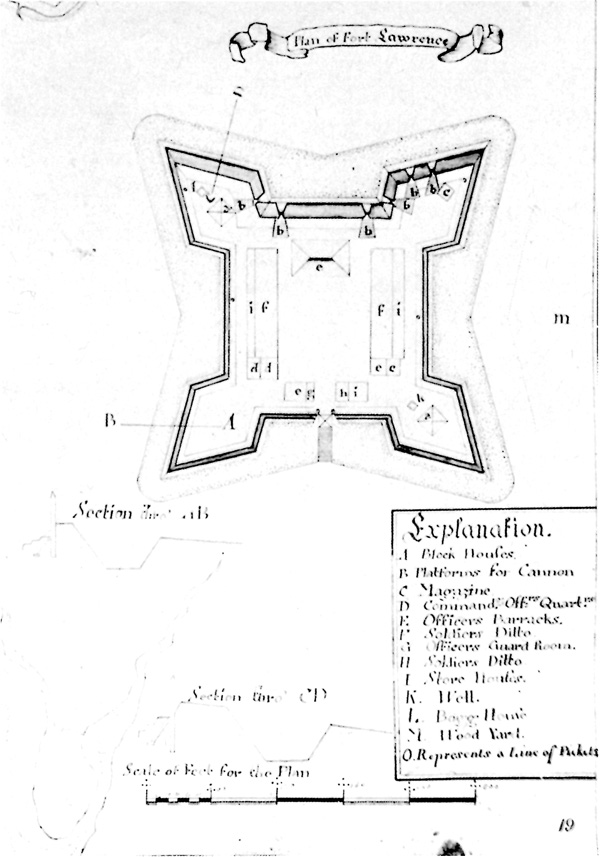
13 Plan of Fort Lawrence, 1755.
(Public Archives of Canada.)
|
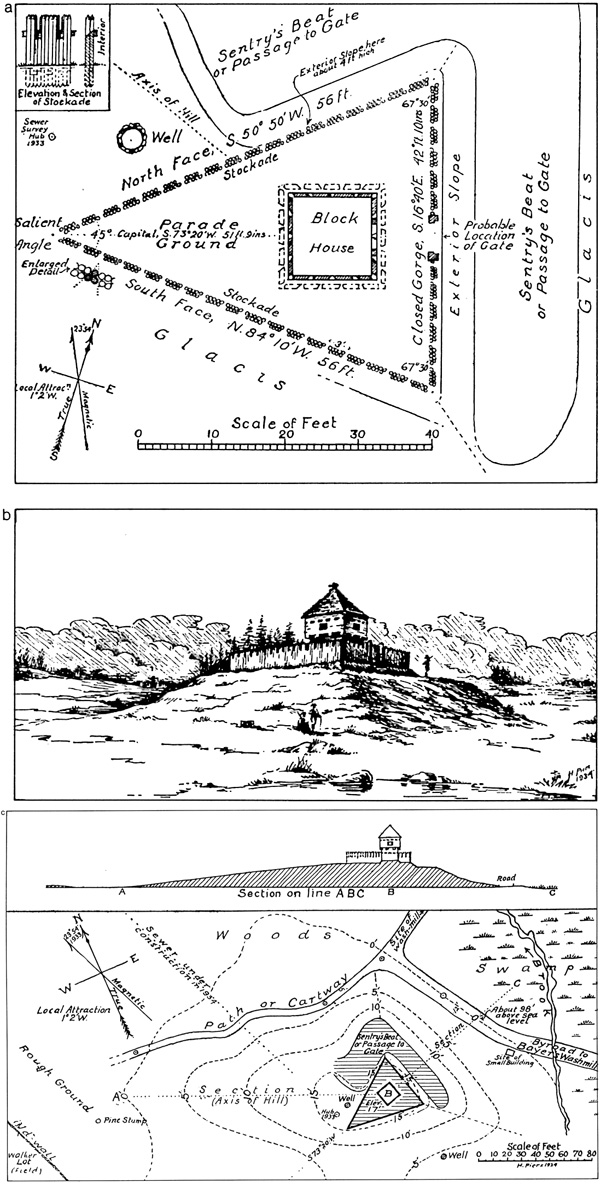
14 The middle peninsula blockhouses at Halifax, 1751, by Harry
Piers; a, plan of the site of the blockhouse and stockade;
b, perspective restoration looking northwest; c, general
contour plan and section of the site.
(Harry Piers, "Old Peninsular Blockhouses and
Road in Halifax, 1751; Their History, Description, and Location,"
Collections of the Nova Scotia Historical Society, Vol. 22 [1933], pp.
96-153.) (click on image for a PDF version)
|
Halifax, Nova Scotia
Like St. John's, Halifax was an important naval base from the day it
was founded, but the geographical features of Halifax harbour, unlike
St. John's, provided no easy answers for protection against sea
assaults. The relative vulnerability of the harbour, however, was
balanced against the fact that an attack on Halifax had to be made
directly by sea: no suitable landing place for troops existed short of
St. Margaret's Bay, 25 tortuous miles to the west. Consequently little
attention was ever given to the landward defences at Halifax except in
the very early period. Efforts at fortification were concentrated at
points on each side of the harbour entrance, and on a series of citadels
behind and above the town. The ultimate safety of the harbour rested
with the power of the British navy. Frantic attempts at fortifying
Halifax in times of war alternated with extended periods of total neglect in
times of peace. The 14 blockhouses built in the Halifax defence system
between 1749 and 1808 were temporary buildings erected in
emergencies.
The three peninsular blockhouses described earlier were the first to
be built at Halifax. These blockhouses were constructed early in the
first winter of the settlement in an attempt to seal off the peninsula
from Indian attacks. The rapid growth of the town, however, and the
large garrison stationed there continued to discourage any attempt by
the Indians against the peninsula. The three small blockhouses built to
meet the rumoured emergency of that first winter very soon became
unnecessary defences.
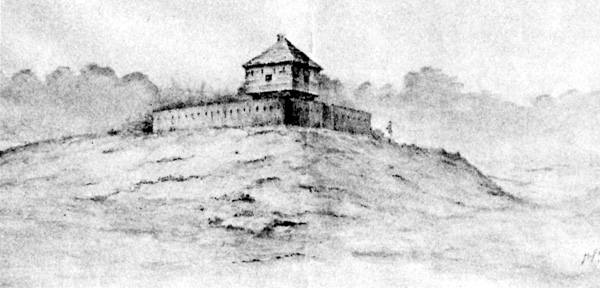
15 Watercolour by Harry Piers of the middle peninsular blockhouse,
Halifax, 1751.
(Public Archvies of Nova Scotia.)
|
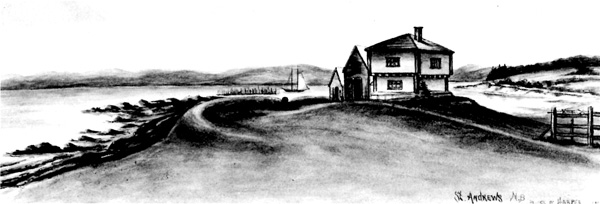
16 Watercolour by Miss S.E. Harper of the west blockhouse
at St. Andrews, New Brunswick.
(New Brunswick Museum.)
|
The Naval Yard
In 1762 the rumour that a large French squadron was cruising the
North Atlantic and the subsequent capture of St. John's, Newfoundland,
in July of that year necessitated hurried preparations at Halifax. Work
on Citadel Hill was halted in order to provide men to strengthen the
batteries at the south end of the peninsula. Attention was also given
for the first time to the defences of the naval yard. Building of the
dockyard had been started in 1759, and its site, north of the town, was
a bad choice from the point of view of defence. Major John Henry
Bastide, the Commanding Royal Engineer at Halifax, had informed General
Amherst a year earlier that "the Naval Yard [could] not possibly be
brought within the line of Defense proposed for the Town."4
The naval yard's security lay in the fact that an enemy could attack it
only after passing the fortifications farther out the harbour. In the
emergency of 1762 the sole measure taken for the defence of the
dockyard and the stores deposited there was the entrenchment of Maugher
blockhouse.5 This blockhouse — placed on a small hill
above the dockyard — had been built before the crisis.
Work on the Halifax fortifications was completely suspended with the
coming of peace in 1763. The problem of the naval yard defences was
left without attention until the American Revolution. By that time, a
great quantity and variety of naval stores for the north Atlantic fleet
was deposited at the Halifax dock yard. Concern about the safety of
these stores was responsible for the government's taking more temporary
measures for the defence of the yard in 1775. Lord Suffolk wrote to
Governor James Legge on the subject,
The ruinous State of the Fortifications at Halifax had been the
Subject of frequent consideration, but as the ablest Engineers who have
been consulted upon it have concurred in opinion that the Harbour is too
extensive and the advantages of Attack too many to admit of any regular
effectual plan; all Ideas of that kind have been laid aside.
It is judged proper however upon the present occasion to direct
that some Works upon a temporary plan of defence should be constructed
for the Security of the King's Naval Yard, and the Board of Ordnance
will by this conveyance send out orders to that Effect to the principal
Engineer at Halifax.6
A month later, in November, Legge reported to Dartmouth that Captain
William Spry, R.E., was employed "in preparing some Temporary Works for
the security of the [naval] Yard."7 In September 1776 Spry
advised General Eyre Massey that three bastions behind the naval yard
were finished, and a double stockade with loopholes completely
surrounded the yard. Two blockhouses had been constructed outside the
north and south walls of the enclosure. Spry also reported that the
blockhouses intended for guardrooms to the bastions and as secondary
defenses of the lines were "ready to raise."8
Fort Needham, north of the naval yard, was also begun in 1776. It was
an earthen redoubt constructed on Pedley's Hill, and was intended to
cover both The Narrows and the naval yard. It contained barracks for 50
men. A blockhouse called Fort Coote was built at the northwest end of
the naval yard on a projecting point. It covered the naval yard and
protected the approach to Fort Needham. Three 18-pounders were mounted
at Fort Coote.9
None of these defences for the naval yard was ever tested, but
Captain James Straton, R.E., wrestling with the same problem in 1796,
criticized the earlier temporary works.
As for putting the Dock Yard, hors d'Insult — from an Enemy
beseiging Citadel Hill Work — it is impossible — not
even the strongest Fortress that could be erected on Needham Hill, would
prevent it — much less the two little Redoubts that were there, and
the three detached Bastions open in the Gorges, and connected only by a
common Picketting, the whole lying on the side of a Hill Just above the
Dock Yard, whose summit effectually commands those Works — and
everything near it. They never could have resisted a spirited
Attack.10
Two other blockhouses were built at Halifax during the Revolution. A
large octagonal blockhouse three storeys high, 50 feet in diameter and
designed to barrack 200 men was constructed in 1776; it was built in a
large square redoubt on the summit of Citadel Hill.11 The
hill's defences consisted, at that time, of a maze of batteries and
irregular earthworks begun by Bastide in 1761 and elaborated by Spry
during the Revolution. The earthen redoubt which occupied the top of
the hill mounted 14 24-pounders in its embrasures. The blockhouse was
built in the centre of the square. Eight six-pounders mounted on the
building's second storey could be fired through portholes in all eight
faces of the octagonal blockhouse, and effectively covered the guns of
the redoubt.
Fort Massey, a square earthen redoubt on a small hill south of the
citadel at the junction of present-day South and Queen streets, was also
built in 1776. Spry reported to Massey on 4 September 1776 that "two 24
pounders [are] mounted, the post defencible, and will be finished in ten
days."12 This redoubt covered the southern approach to the
citadel and protected green-bank and barbette batteries situated below
it. A blockhouse designed to accommodate 39 men was built in the
southeast corner of the redoubt. Two barracks and a small magazine were also
included in the work.13
The fortifications at Halifax were again permitted to fall into
disrepair after the end of the American Revolution. The next crisis to
erupt was the war between England and France in 1793. His Royal
Highness, Edward, Duke of Kent, had taken command of the forces in Nova
Scotia in 1792. The war with France provided Edward with the excuse he
needed to proceed with his plans for reshaping the defences at Halifax.
In spite of the Board of Ordnance's attempts to obstruct him, Edward
managed, during his command at Halifax, to carry out an extensive revision
and strengthening of the Halifax fortifications. Among his works were
two blockhouses.
In 1795 Edward ordered a blockhouse to be built in the rear of the
York Redoubt. Construction of this eight-gun battery had been started
the year before to guard the western entrance to the harbour. The
blockhouse was intended as a keep for the battery and for the small
powder magazine nearby. Artillerymen stationed at the battery were
lodged in the blockhouse, and its second storey mounted two small
carronades.14
Another blockhouse 40 feet square was built inside Edward's star fort
on Georges Island, and provided barracks for the regular troops
stationed on the island. The blockhouse was designed to lodge 40
men.15 Its roof was left flat in order to mount additional
ordnance within the fort.
The renewed war with France in 1807-08 occasioned the building
of more defence works at Halifax. The works which the Duke of Kent had
built a decade earlier were patched up, and two new works were begun at
the north end of the peninsula. Fort Needham had fallen into ruins since
the American Revolution, and it was completely rebuilt in 1808. A
battery was constructed to protect The Narrows at the same time. Midway
between the refurbished fort and the new battery, a blockhouse was built
in 1808. It stood slightly to the north of Fort Needham, and mounted two
12-pounders in its second storey. It also contained a small magazine.
This blockhouse covered the battery and protected the northern
approaches to Fort Needham.16 Another blockhouse was
constructed inside Fort Needham redoubt in order to replace the
barracks, which were out of repair. General Hunter had received
approval to erect a stone tower in the fort, but the shortage of time
and manpower forced him to build the blockhouse as a temporary
measure.
Repeated proposals had been made since 1760 to provide once more for
the defence of the narrow neck of the peninsula. The recommendations
made usually suggested a series of redoubts with blockhouses and
batteries en barbette to occupy the high points of land between the
Northwest Arm and Bedford Basin. Fort McAlpine, which General Hunter
ordered built in 1808, was the only defence ever erected for this area.
It was a large pentagonal redoubt with a two-storey pentagonal
blockhouse inside which was begun in the summer of 1808. The work was
intended to cover the approach to Halifax from the Bedford road, and to
prevent troops from landing on the north shore of the
peninsula.17 The three blockhouses built in 1808 were the
last to be erected in Halifax.

17 Watercolour by Capt. Reid of the east
blockhouse at St. Andrews, New Brunswick.
(New Brunswick Museum.)
|
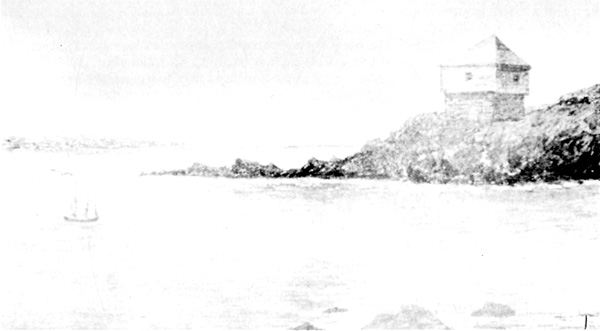
18 A sketch of the Liverpool blockhouse.
(Public Archives of Nova Scotia.)
|
Saint John, New Brunswick
The harbour and town of Saint John was a post of only minor
importance to the British. But by the time of the American Revolution
the supply of timber from the Saint John River area was becoming
absolutely necessary for providing masts for the British navy; moreover
the river was the only communication route between Quebec and Halifax in
time of war. The troublesome raids made by Ethan Allen and his company
of rangers into New Brunswick and Nova Scotia prompted General Massey to
write to General Howe in 1777 asking for reinforcements to establish a
post at the mouth of the Saint John River, a request which Howe
approved. In November 1777, Massey sent Captain Shudholme with 50 men
and two frigates to establish the post. With them were a small
blockhouse (prefabricated in Halifax) and four six-pounders to be
mounted in it, to facilitate the troops' task.18 The
blockhouse was erected, palisades dug in, and an abatis thrown up before
winter set in. A barracks for 100 men was added during the winter. The
post was named Fort Howe. It was situated on a high ridge at the
northern extremity of the harbour, which it commanded; immediately
across the harbour from it were the ruins of Fort Frederick. Another
blockhouse was built the next year, at the other end of the high ridge
overlooking the Saint John River.19
In the crisis of 1793, Governor Thomas Carleton thought it proper and
necessary to build some temporary defences against sudden attack.
Dorchester Battery was erected at the southern end of the Saint John
peninsula. Behind it, a 20-foot-square blockhouse was built to protect
the new work. The blockhouse mounted four four-pounders in the second
storey. Mortar Battery, Graveyard Battery and Prince Edward Battery
were built in the same year. Carleton informed Dundas that he had
undertaken these works on his own authority, but that "by the voluntary
assistance of the Inhabitants, I was Enabled to execute [the works]
without incurring any expence to Government."20
Not until the War of 1812 were any further measures undertaken to
defend Saint John. With the outbreak of the war, attempts were made to
put the town and harbour into a state of defence sufficient to repulse
any small, sudden American attacks. If there was ever a large regular
siege, the troops at Saint John were to embark in a flotilla of boats
and retreat up the Saint John River, which could be easily defended
against a pursuing army.
The fortifications built at Saint John during the War of 1812 were
concentrated on the peninsula where the town stood and along the western
shore of the harbour. (The eastern side was considered indefensible.)
The British strategy was that, if the harbour could be adequately
covered by the guns of the peninsula, the western shore and Partridge
Island, then the enemy could not land on the eastern side. If a hostile
fleet could be kept out of the harbour, there was no suitable landing
place closer than 50 miles to the east.21
The line of defence began with Dorchester Battery and blockhouse,
which were located on the southwestern tip of the peninsula. The
battery and blockhouse were built in 1793 and were strengthened during
the War of 1812. In 1815 the battery mounted two 24-pounders on
traversing platforms. The blockhouse, which was 20 feet square in the
lower storey, stood immediately in the rear of the battery. The
blockhouse's upper storey mounted two four-pounders to cover the guns in
front and to prevent an assault by land in the rear.22
Mortar Battery was located 211 yards west of the Dorchester
emplacement. In 1811 this battery mounted three 24-pounders on
traversing platforms, two eight-inch mortars and one eight-inch
howitzer.23 The battery was a semicircular earthwork which
was intended to cover the entrance to the inner harbour.
Graveyard Battery was located 150 yards north of Mortar Battery. It
was a semicircular work which mounted three 24-pounders on traversing
platforms24 and commanded the inner harbour. It had no
blockhouse.
About a quarter of a mile from the Graveyard Battery guns was a small
circular barbette work called Prince Edward Battery. The five
18-pounders mounted there commanded the inner harbour.25 The
work was situated near water level.
At the back of the town, on a hill commanding the main road into the
settlement from the interior, Johnston's battery and blockhouse were
built. This work was begun in 1811 and was completed during the war. The
battery mounted two nine-pounders on wooden platforms. The second
storey of the blockhouse contained two four-pounders.26
At the northern end of the harbour, at the base of Fort Howe hill,
stood the stone powder magazine capable of containing 750 barrels of
powder. On the hill above the magazine, Fort Howe, the small stockaded
work built in 1777, lay in near ruin. The rotten stockades and four
six-pounders in the blockhouse provided a focal point for the defence of
the town and magazine below.27 Slightly to the west and rear
of Fort Howe stood the blockhouse built in 1778. This position
commanded Fort Howe and the mouth of the Saint John
River.28
The fortifications defending the western shore of the harbour began
with Fort Frederick. This fort, which had been established in 1758 by
Colonel Robert Monckton, was in almost total decay. The fort stood at
water level, on a small point of land near the mouth of the river
directly across the harbour from the town and Fort Howe. In July 1812,
Captain McLaughlan, the resident Royal Engineer at Saint John, decided
that the fort should be reconstructed. He believed that guns situated at
this point would provide a good extra defence of the inner harbour and
the town, and would support the batteries on the opposite shore. If an
enemy succeeded in taking Fort Frederick, he could not turn the guns
against the town; the fort was commanded by the heights of Fort
Howe.29 Nicolls, the Commanding Royal Engineer at Halifax,
could see little sense in spending money to rebuild a fort which was
commanded on all sides.30 However, Major General George
Smith, the commander of the New Brunswick forces, instructed McLaughlan
to proceed with his plans for reconstructing Fort Frederick and to begin
the one-storey blockhouse the latter recommended be built
there.31
A blockhouse called Fort Drummond was begun in July 1812. It was
built 1,400 yards along the western shore from Fort Frederick and was
identical to Dorchester Battery blockhouse. It mounted one four-pounder
and one six-pounder on wooden carriages in the upper
storey.32 The ammunition for these guns was stored at Fort
Frederick. The Drummond blockhouse stood on a hill which commanded the
road to Musquash. If an enemy were to land in Magaguadavic Bay, he would
have to pass the work in an advance on the town.
Carleton Tower, the first Martello tower to be built at Saint John,
was begun in July 1814. The tower stood on a hill 200 yards behind
Drummond blockhouse and commanded both the blockhouse and the road to
Musquash as well as the western side of the harbour. Three four-pounders
were mounted in the second floor of the tower and two long 24-pounders
were mounted on its top.33
Partridge Island, at the southwest end of Saint John Harbour, was the
final and most important defence on the western side. Late in 1812, the
lighthouse on the island was converted to a musket-proof barracks for 60
men. The level ground on which the lighthouse stood was enclosed with an
earthen parapet 5.5 feet high. Six 24-pounders mounted behind the
parapet34 commanded both the eastern and western channels of
the harbour. In November 1812, McLaughlan began a blockhouse in the
opposite quarter of the parapet curve from the lighthouse.35
This blockhouse was built to provide quarters for the officers stationed
on the island, and a cookhouse for the men lodged in the lighthouse.
The seven blockhouses described above were the only ones constructed
at Saint John.
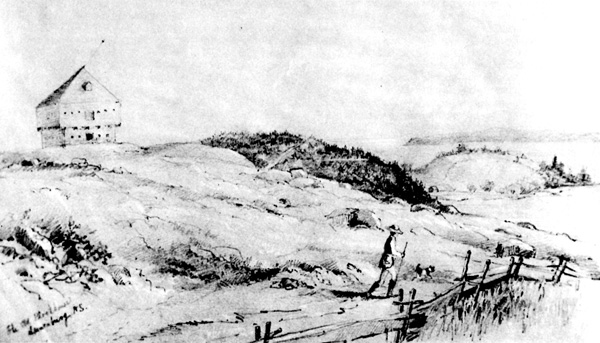
19 Blockhouse on Windmill Hill, Lunenburg.
(Public Archives of Nova Scotia.)
|
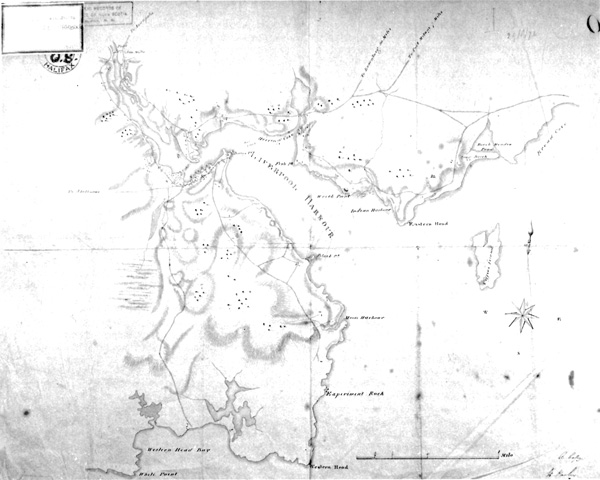
20 Map by Lt. Pooley, RE, of Liverpool
Harbour, 1820.
(Public Archives of Nova Scotia.)
|
Kingston, Ontario
The necessity of establishing an alternative post at the head of the
St. Lawrence River developed in 1794, when Britain finally agreed to
withdraw her troops from those western posts which lay, it was
determined, in American territory. The post at Carleton Island, which
Twiss had begun in 1778 and which had served as the naval depot for
Lake Ontario and as the transshipment point for supplies to the western
posts, had to be abandoned. Despite some serious objections about
shallow water and the problems of fortifying the place, the British
chose as their alternative Haldimand's Cove, near Kingston. Approval of
the site and authorization to fortify it came from England in 1794. The
Duke of Portland wrote to Dorchester,
should Haldiman's Cove, near Kingston, be found to be better
adapted than any other place, for the immediate purpose of a Military
Post, and for connecting the necessary Communication and Carriage of
Stores etc. between Lower and Upper Canada, your Lordship will of course
fortify it with that view.36
The problem of strengthening the cove to protect the naval depot
proved to be a formidable one. The high ground at Point Henry could not
be occupied as a citadel without an elaborate and expensive system of
fortification. The rising ground on the west side of Kingston harbour
behind the town commanded the harbour, Point Frederick, Navy Bay and the
dockyard. No single system of defence could occupy the whole area. In
the absence of any simple, inexpensive solution to the problem of
defending Kingston, the British relied on continuing peace with the
United States and ignored the question of the harbour's fortifications.
A report on the state of the fortified military posts in Upper Canada,
prepared by Lieutenant Colonel Bruyeres for Prevost in August 1811, did
not mention Kingston.37
Sir George Prevost was aware of the undefended state of Kingston, and
fully realized that an American attack on the post would cut
communications between Upper and Lower Canada and deprive the British of
the naval resources of Lake Ontario.38 Several times in the
first year of the War of 1812, Prevost considered moving the naval
stores to York in order to get them away from the American frontier; but
the need for a strong post at the head of the line of navigation of the
St. Lawrence and the momentum of the war delayed his decision.
In the meantime, Kingston had become established and would have
proved difficult to move. The naval depot, dockyard and shipbuilding
yards remained where they were. The post's importance increased as the
war proceeded. The garrison was increased considerably in the summer and
fall of 1812, and temporary works for the harbour's defence were begun.
During the war, extensive work was undertaken at Point Henry for the
protection of the naval yard. A series of batteries and blockhouses was
erected at various other points in an attempt to protect the town and
harbour. These works were all temporary ones, intended to take the best
advantage of the ground that time allowed.
In the first months of the war, a battery was begun on Point
Frederick to protect the entrances to Kingston harbour and Navy Bay. A
small blockhouse was constructed behind the battery in order to cover
the work and to provide barracks for the artillerymen. When Lieutenant
Colonel Bruyeres visited Kingston in December 1812, he recommended that
another blockhouse be built on Point Frederick. This blockhouse was to
be much larger than the one supporting the battery: 48 feet square in
the lower storey, and capable of barracking 160 men in hammocks.
Bruyeres hoped that this blockhouse would provide additional protection
for the dockyard.39 Work on the blockhouse began in the
spring of 1813. It was located where the Martello tower on Point
Frederick now stands.
To protect the outer channels of Kingston harbour, a small blockhouse
and single-gun battery were established on Snake Island in 1813. The
island is about four miles southwest of the mouth of the
harbour.40 Work also began in 1813 on the defences for the
western side of the harbour and the defence of the high ground behind
the town. The object of the batteries and blockhouses built there was to
prevent an enemy landing on the western shore near the town. In
addition, if the Americans could have occupied the rising ground behind
the town, their cannon would have commanded the entire area, except Fort
Henry. However, the ground was too extensive and time
was too short to prepare anything but a series of small works
connected by a line of palisades.41
The defences on the western side of the harbour began at Murney's
Point where a redoubt (consisting of an earthwork battery with
blockhouse en barbette) was constructed in 1813.42 About midway between
Murney's Redoubt and the battery on Mississauga Point, a small
blockhouse was built on the water's edge to protect the end of the line
of picketing behind the town.43 On Mississauga Point, a
four-gun battery co-operated with the battery at Point Frederick to
defend the entrance to the inner harbour. Behind Mississauga Point, on
rising ground which commanded the battery, blockhouse no. 1 was built.
Blockhouse no. 2 was erected on a triangular piece of land at the corner
of Grass and School streets. This work was the second in the line of
palisades rising behind the town. Blockhouse no. 3 was the next work in
the line. Here the picketing was formed into a bastion and the
blockhouse stood in the gorge.44 Midway between this work and
blockhouse no. 4, a redan was formed in the palisading and a line
barracks established. Blockhouse no. 4 was situated on a hill
overlooking the main road entering Kingston from York. The picketing at
this point was formed into a bastion with the blockhouse inside.
Blockhouse no. 5 commanded the main road out of Kingston toward
Gananoque, and was the last post in the line. The picketing was formed into
a bastion around the blockhouse, and then continued sharply down the
hill to the water's edge.45
Since all the blockhouses built in this line of picketing were
erected at the same time and for the same general reasons, it may be
safe to assume that they were very similar to each other, if not
identical. They were all intended primarily as defensible barracks.
Blockhouse no. 5 measured 30 feet square in the lower storey, and was
reported to be capable of containing 45 men on iron
bedsteads.46 Blockhouse no. 2 was described as being similar
to no. 5.47 The only visual evidence available is a painting of an "old
blockhouse at Kingston"; the blockhouse is not identified (see
Fig. 39) but is probably no. 5.
The ten blockhouses built at Kingston in the War of 1812 were the
only ones ever erected there.
|

